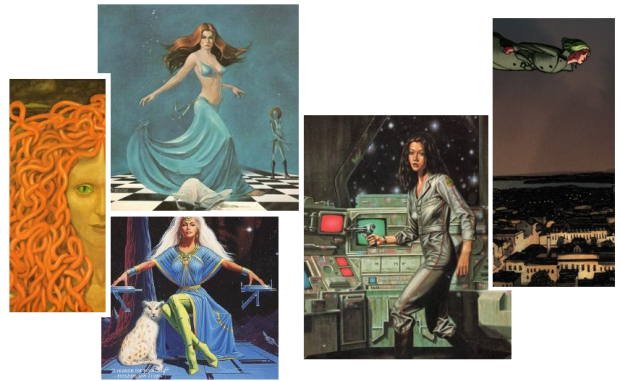
.
Science-Fiction-Romane von Autorinnen – die ich las und empfehlen kann:
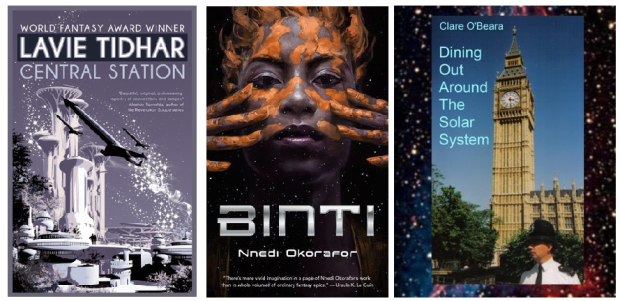
- April 2016, 240 Seiten
- Armut, Cyberpunk und Kulturimperialismus in Tel Aviv
„A worldwide diaspora has left 250,000 people at the foot of a space station. Cultures collide in real life and virtual reality. When Boris Chong returns to Tel Aviv from Mars, much has changed. His ex-lover is raising a child who can tap into the datastream of a mind with the touch of a finger. His cousin is infatuated with a robotnik—a damaged cyborg soldier who might as well be begging for parts. And a [female] hunted data-vampire has followed Boris. Everything is connected by the Others. At Central Station, humans and machines continue to adapt, thrive… and even evolve.“ [Klappentext, gekürzt]
02: Nnedi Okorafor, „Binti“
- 2015, 96 Seiten
- Novelle der wichtigsten nigerianischen Sci-Fi-Autorin
„Binti is the first of the Himba people ever to be offered a place at Oomza University, the finest institution of higher learning in the galaxy – among strangers who do not share her ways or respect her customs. Knowledge comes at a cost, one that Binti is willing to pay.“ [Klappentext, gekürzt]
03: Clare O’Beara, „Dining Out Around the Solar System“
- 2013, 1200 Seiten
- 1200 Seiten? Die ersten wirkten flüssig, originell, klug, gut gelaunt.
„While exploring the other planets, we found that they were all inhabited. Now those people are coming to Earth and looking for work. They’re also opening ethnic restaurants in central London […while] Londoners are recruited to mine the asteroids. Two book reviewers and trainee journalists: Donal, an Irish lad, and Myron, a Cockney-Jamaican mix befriend the immigrants, while their investigative reporting lands them in trouble with wealthy organisations, criminals and the Home Office.“ [Klappentext, gekürzt]
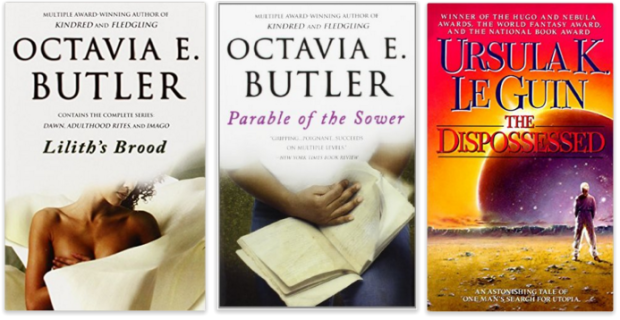
.
04: Octavia Butler: „Lilith’s Brood“ (Xenogenesis-Trilogie)
- 1987, 746 Seiten
- die wichtigste feministische SciFi-Autorin: das hier ist ihr Hauptwerk
„Lilith Iyapo is in the Andes, mourning the death of her family, when war destroys Earth. Centuries later, she is resurrected — by miraculously powerful unearthly beings, the Oankali. Driven by an irresistible need to heal others, the Oankali are rescuing our dying planet by merging genetically with mankind. But Lilith and all humanity must now share the world with uncanny, unimaginably alien creatures: their own children.“ [Klappentext]
.
05: Octavia Butler: „Parable of the Sower“ (Band 1 der Earthseed-Reihe)
- 1993, 345 Seiten
- Postapokalyptisch… aber mir vielleicht zu spirituell/eso.
„When environmental and economic crises lead to social chaos, Lauren Olamina, a minister’s young daughter, loses her family and ventures out into the unprotected American landscape. What begins as a flight for survival soon leads to something more: a startling vision of human destiny… and the birth of a new faith.“ [Klappentext, leicht gekürzt]
.
06: Ursula K. Le Guin: „The Dispossessed“
- 1974, 387 Seiten
- noch spiritueller, noch esoterischer: die Beschreibung reizt mich nicht – aber viele, viele Menschen lieben das sehr (und wünschen sich gute Verfilmungen)
„Shevek, a brilliant physicist, wants to tear down the walls of hatred that have isolated his planet of anarchists from the rest of the civilized universe. He must make the unprecedented journey to the utopian mother planet, Urras.“ [Klappentext, gekürzt; auch „The Word for World is Forest“ wirkt vielversprechend]
.
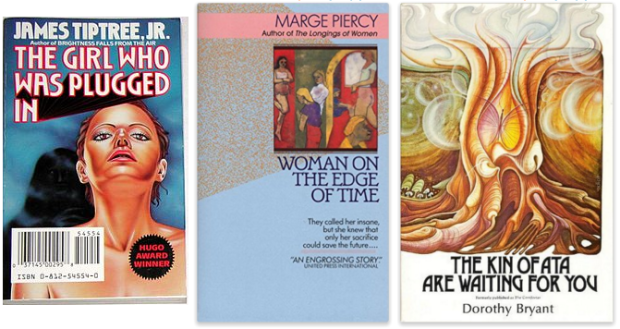
07: James Tiptree, Jr.: „The Girl who was plugged in“
- 1973, ca. 30 Seiten, auch online als .pdf zu finden
- medien- und sexismuskritische Erzählung einer Autorin, die sich selbst hinter einem Männernamen verbarg
„In the future, almost everything is controlled by corporate interests. Despite advertising being illegal, corporations control consumers through the celebrities they set up, and product placement. Seventeen-year-old Philadelphia Burke is enlisted to become one of these celebrities.“ [Wikipedia-Zusammenfassung, gekürzt]
.
08: Marge Piercy: „Woman at the Edge of Time“
- 1976, 376 Seiten
- Irrsinn oder Klarsicht: feministische Parabel über eine Frau, der niemand glaubt und zuhört.
„Connie Ramos, a woman in her mid-thirties, has been declared insane. But Connie is overwhelmingly sane, merely tuned to the future, and able to communicate with the year 2137. As her doctors persuade her to agree to an operation, Connie struggles to force herself to listen to the future and its lessons for today….“ [Klappentext]
.
09: Dorothy Bryant: „The Kin of Ata are waiting for you“
- 1971, 228 Seiten
- Ich las die alte, vergriffene deutsche Ausgabe an und fand es kitschig, geschwätzig. Problem der Übersetzung? Oder Insel-/Stammes-/Fantasy-Kitsch?
„Part love story, part utopian fantasy, part spiritual fable: Into the world of the Ata comes a desperate man, running from a fast life of fame and fortune, drugs and crime. He is led by the kin of Ata on a spiritual journey.“ [Klappentext, gekürzt; Gerd Brantenbergs „Egalia’s Daughters“, angelesen und gemocht, geht in eine ähnliche Richtung]
.
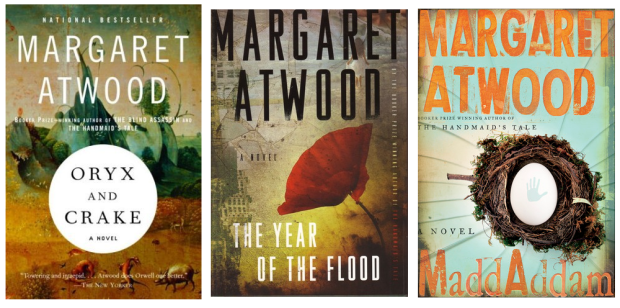
10: Margaret Atwood: „Oryx & Crake“ […vielleicht die komplette Trilogie]
- 2003, 374 Seiten
- postapokalyptisches Märchen. Ich finde Atwood oft zu didaktisch, trocken, von-oben-herab. Aber: tolle Kritiken, stilistisch toll, viele Fans.
„Snowman, known as Jimmy before mankind was overwhelmed by a plague, might be the last human after powerful corporations took mankind on an uncontrolled genetic engineering ride. He embarks on a journey–with the help of the green-eyed Children of Crake–through the lush wilderness that was so recently a great city.“ [Klappentext, gekürzt]
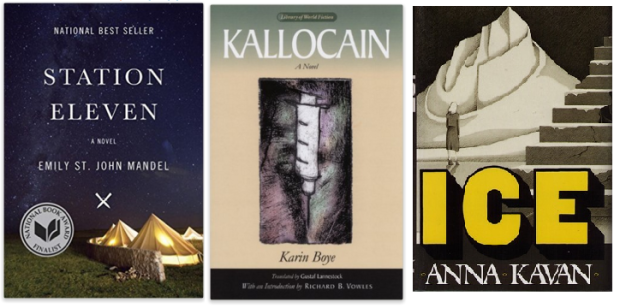 .
.
11: Emily St. John Mandel: „Station Eleven“ / „Das Licht der letzten Tage“
- 2014, 336 Seiten
- stiller, melancholischer Roman über Kunst (Wandertheater) und Alltag nach einer Seuche
„A nomadic group of actors roaming the scattered outposts of the Great Lakes region, risking everything for art and humanity: A terrible flu begins to spread. Fifteen years later, Kirsten is an actress with the Traveling Symphony. Written on their caravan, and tattooed on Kirsten’s arm is a line from Star Trek: „Because survival is insufficient.“ A suspenseful, elegiac novel – spanning decades, moving back and forth in time, and vividly depicting life before and after the pandemic.“ [Klappentext, gekürzt]
.
12: Karin Boye: „Kallocain“
- 1940, 224 Seiten
- frühe Dystopie / Kritik an totalitären Folterstaaten
„This classic Swedish novel envisioned a future of drab terror. Seen through the eyes of idealistic scientist Leo Kall, Kallocain’s depiction of a totalitarian world state is a montage of what novelist Karin Boye had seen or sensed in 1930s Russia and Germany. Its central idea grew from the rumors of truth drugs that ensured the subservience of every citizen to the state.“ [Klappentext]
.
13: Anna Kavan: „Ice“
- 1967, 158 Seiten
- kurzer, nihilistischer Endzeit-Roman
„In this haunting and surreal novel, two men search for a reclusive girl against a background of nuclear war, resulting in total destruction by walls of ice that overrun the world. With the narrator the reader is swept into a hallucinatory quest through the encroaching ice.“ [Klappentext]
.
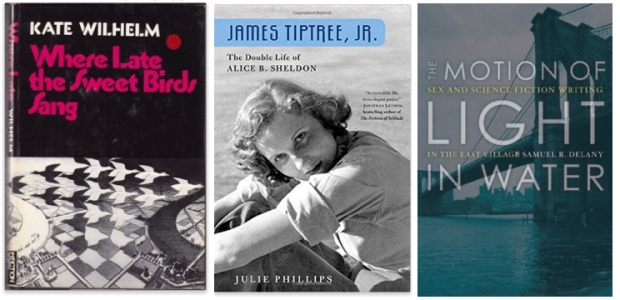
14: Kate Wilhelm: „Where Late the Sweet Birds Sang“
- 1976, 251 Seiten
- Wie kann man eine Zivilisation bewahren – technisch und kulturell?
„The spellbinding story of an isolated postapocalyptic community determined to preserve itself through a perilous experiment in cloning. Sweeping, dramatic, rich with humanity, and rigorous in its science, the novel is regarded as a high point of both humanistic & hard SF.“ [Klappentext, gekürzt]
.
15: Julie Phillips: „James Tiptree, Jr.: The Double Life of Alice B. Sheldon“
- 2006, 469 Seiten
- Biografie einer der wichtigsten SciFi-Autorinnen
„James Tiptree, Jr. burst onto the science fiction scene in the 1970s with a series of hard-edged, provocative short stories. Hailed as a brilliant masculine writer with a deep sympathy for his female characters. For years he corresponded with Philip K. Dick, Harlan Ellison, Ursula Le Guin. Then the cover was blown on his alter ego: A sixty-one-year old woman named Alice Sheldon. As a child, she explored Africa with her mother. She was an artist, a chicken farmer, a World War II intelligence officer, a CIA agent, an experimental psychologist. Devoted to her second husband, she struggled with her feelings for women. In 1987, her suicide shocked friends and fans.“ [Klappentext, leicht gekürzt]
.
16: Samuel R. Delany: „The Motion of Light in Water: Sex and Science Fiction Writing in the East Village“
- 1988, 584 Seiten
- Autobiografie des wichtigsten schwulen und schwarzen SciFi-Autors.
„Born in Harlem at the start of World War II, Samuel R. Delany married white poet Marilyn Hacker right out of high school. The interracial couple moved into the city’s new bohemian quarter, the Lower East Side, in summer 1961. Through the decade’s opening years, new art, new sexual practices, new music, and new political awareness burgeoned. A black gay writer in an open marriage.“ [Klappentext, gekürzt]
.
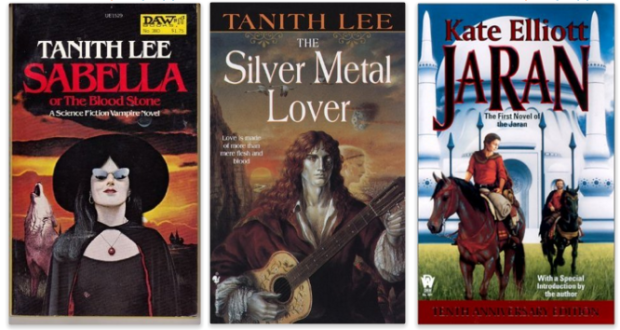
17: Tanith Lee: „Sabella“
- 1980, 157 Seiten
- Hipster-/Pulp-Roman über eine feministische (?) Vampirin auf dem Mars
„DRACULA? A mere figment of superstition, a thing that could not exist. SABELLA? A very real person, who required the blood of young men to feed upon. Sabella was alive, sensual and dangerous. She lived on Nova Mars, and her very existence was a peril to the population of that world.“ [Klappentext, gekürzt]
.
18: Tanith Lee: „The Silver Metal Lover“
- 1981, 291 Seiten
- Mädchen liebt Roboter: Ich mag keine Geschichten, die Kunstwesen idealisieren und die ewiggleichen „Bin ich ein echter Junge?“-Pinocchiofragen stellen – doch das hier wirkt kompetent geschrieben/erzählt.
„Sixteen-year-old Jane and her friends are children of the privileged class, living in luxury on an Earth remade by natural disaster. Until a chance encounter with a robot minstrel with auburn hair and silver skin. Jane is certain that Silver is more than just a machine built to please. So she escapes into the city’s violent, decaying slums to embrace a love bordering on madness.“ [Klappentext, gekürzt]
.
19: Kate Elliott: „Jaran“
- 1992, 496 Seiten
- Im schlimmsten Fall ist das eine Fantasy-Liebesschmonzette mit Weltraum-Indianern. Doch die Leseprobe wirkte überraschend kompetent erzählt.
„Earth is just one of the planets ruled by the vast Chapalii empire. Tess Soerensen’s brother Charles rebelled against them at one time and was rewarded by being elevated into their interstellar system—yet there is reason to believe they murdered his and Tess’s parents. Tess sneaks aboard a shuttle bound for Rhui, one of her brother’s planets. On the ground, she joins up with the native jaran people, becoming immersed in their nomadic society and customs. As she grows ever closer to the charismatic jaran ruler, Ilya, Tess must choose between her feelings for him and her loyalty to her brother.“ [Klappentext, gekürzt]
.
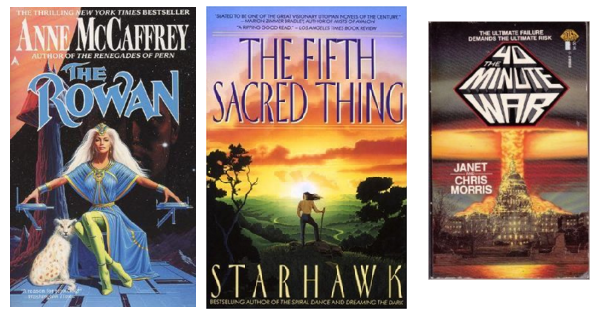
20: Anne McCaffrey: „The Rowan“
- 1990, 336 Seiten
- Frau ist begabt. Wird benutzt, eingeschüchtert, unter Druck gesetzt… und wächst über sich hinaus. Vielleicht zu parabelhaft/dick aufgetragen…?
„The kinetically gifted, trained in mind/machine gestalt, are the most valued citizens of the Nine Star League. Using mental powers alone, these few Prime Talents transport ships, cargo and people between Earth’s Moon, Mars‘ Demos and Jupiter’s Callisto. An orphaned young girl, simply called The Rowan, is discovered to have superior telepathic potential and is trained to become Prime Talent on Callisto. After years of self-sacrificing dedication to her position, The Rowan intercepts an urgent mental call from Jeff Raven, a young Prime Talent on distant Deneb. She convinces the other Primes to merge their powers with hers to help fight off an attack by invading aliens. Her growing relationship with Jeff gives her the courage to break her status-imposed isolation, and choose the more rewarding world of love and family.“ [Klappentext; auch McCaffreys „Freedom’s Landing“ will ich lesen.]
.
21: Starhawk: „The Fifth Sacred Thing“
- 1993, 698 Seiten
- Schon beim Autorinnennamen-Namen höre ich Alarmglocken – doch ich glaube, das sind kalifornisch-softe, warmherzige Bücher über Zuhause, Kommunen, Weltverbesserung.
„Freedom and slavery, love and war, and the potential futures of humankind: A twenty-first century California clan caught between two clashing worlds – one based on tolerance, the other on repression.“ [Klappentext, gekürzt]
.
22: Janet E. Morris: „The 40 Minute War“
- 1980, 210 Seiten
- Simpler (?), reißerischer Thriller mit sehr vielen Fans.
„After Washington, D.C. is vaporized by a nuclear surface blast, Marc Beck of the American foreign service wants to fly two batches of anticancer serum from Israel to the Houston White House. Beck must deal with one cliffhanger after another. This novel shocks us with a sudden, satisfying ending.“ [Klappentext/Zitat von Publisher’s Weekly, gekürzt]
.

23: Nancy Kress: „Beggars in Spain“
- 1993, 400 Seiten
- Das für mich interessanteste Konzept hier auf der Liste.
„Leisha Camden was genetically modified at birth to require no sleep, and her normal twin Alice is the control. Problems and envy between the sisters mirror those in the larger world, as society struggles to adjust to a growing pool of people who not only have 30 percent more time to work and study than normal humans, but are also highly intelligent and in perfect health. The Sleepless gradually outgrow their welcome on Earth, and their children escape to an orbiting space station to set up their own society. But Leisha and a few others remain behind, preaching acceptance for all humans.“ [Klappentext, gekürzt]
.
24: Joan Slonczewski: „A Door Into Ocean“
- 1986, 403 Seiten
- Schwergewicht/Klassiker, auf jeden Fall einen längeren Blick wert.
„A ground-breaking work both of feminist SF and of world-building hard SF, it concerns the Sharers of Shora, a nation of women on a distant moon in the far future who are pacifists, highly advanced in biological sciences, and who reproduce by parthenogenesis–there are no males–and tells of the conflicts that erupt when a neighboring civilization decides to develop their ocean world, and send in an army.“ [Klappentext]
.
25: Maureeen F. McHugh: „China Mountain Zhang“
- 1992, 313 Seiten
- Cyberpunk-Favorit aus den 90ern. Vielleicht zu… barock/überfrachtet?
„We enter a postrevolution America, moving from the hyperurbanized eastern seaboard to the Arctic bleakness of Baffin Island; from the new Imperial City to an agricultural commune on Mars. The overlapping lives of cyberkite fliers, lonely colonists, illicit neural-pressball players, and organic engineers blend into a powerful, taut story of a young man’s journey of discovery. This is a macroscopic world of microscopic intensity“ [Klappentext, gekürzt]
.
26: Connie Willis: „Bellwether“
- 1996, 248 Seiten
- Sehr geschätzte, bewunderte Autorin. Ich habe auf DIESES Buch von ihr die meiste Lust – weil ich auf Schwung/Leichtigkeit hoffe… und kluge Kapitalismuskritik.
„Sandra Foster studies fads and their meanings for the HiTek corporation. Bennet O’Reilly works with monkey group behavior and chaos theory for the same company. When the two are thrust together due to a misdelivered package and a run of seemingly bad luck, they find a joint project in a flock of sheep. Pop culture, chaos theory and matters of the heart collide in this unique novella.“ [Klappentext, gekürzt]
.

27: Young Adult: Joelle Charbonneau, „The Testing“
- 2013, 325 Seiten
- Standard-Cover, Standard-Plot… doch die ersten Seiten wirkten wie ein perfektes Buch für Menschen, die von „Allegiant“ usw. enttäuscht waren.
„The Seven Stages War left much of the planet a charred wasteland. The future belongs to the next generation’s chosen few who must rebuild it. But to enter this elite group, candidates must first pass The Testing—their one chance at a college education and a rewarding career. Cia Vale is honored to be chosen as a Testing candidate. Can she trust Tomas, her handsome childhood friend who offers an alliance? To survive, Cia must choose: love without truth or life without trust.“ [Klappentext, gekürzt]
.
28: Young Adult: Anne Tibbets, „Carrier“
- 2014, 236 Seiten
- Young Adult? New Adult? Eine erwachsene Hauptfigur mit Kindern, verliebt in einen Rebellen: Im schlimmsten Fall ist das (nur) postapokalyptische Romance. Trotzdem: gute Leseprobe.
„Twenty-two -year-old Naya has spent nearly half her life as a sex slave in a government institution called The Line. When she’s kicked out after getting pregnant with twins, she’s got no way to earn a living and a horrifying choice to make: find someone to replace her, or have her babies taken in her stead.“ [Klappentext, gekürzt]
.
29: Young Adult: J.A. McLachlan, „The occassional Diamond Thief“
- 2014, 250 Seiten
- nicht-weiße Hauptfigur, schöne Figurendynamik, Respekt vor anderen Planeten/Kulturen: Das kann gut werden – falls es nicht zu belehrend erzählt.
„On his deathbed, Kia’s father discloses a secret: a magnificent diamond from the distant colonized planet of Malem, where her father caught the illness that eventually killed him. While training to be a translator, Kia is co-opted into travelling to Malem. Using her skill in languages and the skill of picking locks, she wants to return the diamond to its original owner. Kia is quirky, with an ironic sense of humour and a loner. Her sidekick, Agatha, is hopeless in languages and naive to the point of idiocy in Kia’s opinion, but possesses the wisdom and compassion Kia needs.“ [Klappentext, gekürzt]
.
30: Young Adult: Wendy S. Russo, „January Black“
- 2013, 336 Seiten
- Philosophische Fantasy? Ein gesellschaftskritischer Bildungsroman? Eine Märchen-Parabel? Lauter Versatzstücke, die mich oft abstoßen. Trotzdem: vorsichtig optimistisch.
„Sixteen-year-old genius Matty Ducayn is the son of The Hill’s commandant. To prove his worth to society, Matty wrestles with the king’s word games and meets Iris Locke, a street smart gardener, along the way. Matty finds himself on collision course with a deadly law, one he will have to break to answer the king’s question. Was Hadrian challenging him, or teaching him a lesson?“ [Klappentext, gekürzt]
.
31: Young Adult: Julie Mayhew, „The Big Lie“
- 2015, 384 Seiten
- letztes Jahr angelesen und sehr gemocht: Ich hoffe, das kommt nach Deutschland.
„Contemporary Nazi England: Jessika Keller obeys her father and does her best to impress Herr Fisher at the Bund Deutscher Mädel meetings. Her neighbour Clementine is outspoken and radical. And the regime has noticed. Jess cannot keep both her perfect life and her dearest friend. But which can she live without?“ [Klappentext, gekürzt]
.

32: Kinderbuch/Middle-Grade-Novel: Margaret Haddix Peterson, „Among the Hidden“
- 1998, 153 Seiten
- siebenbändige Kinder-Thrillerreihe, die auch oft im (deutschen) Englisch-Unterricht als Lektüre benutzt wird; wahrscheinlich recht konventionell.
„Luke has never been to school. He’s never had a birthday party, or gone to a friend’s house for an overnight. In fact, Luke has never had a friend. Luke is one of the shadow children, a third child forbidden by the Population Police. He’s lived his entire life in hiding, and now, with a new housing development replacing the woods next to his family’s farm, he is no longer even allowed to go outside. Then, one day Luke sees a girl’s face in the window of a house where he knows two other children already live. Finally, he’s met a shadow child like himself. Jen is willing to risk everything to come out of the shadows — does Luke dare to become involved in her dangerous plan?“ [Klappentext, leicht gekürzt]
.
33: Kinderbuch/Middle-Grade-Novel: Diana Wynne Jones, „Howl’s Moving Castle“
- 1986, 336 Seiten
- Verfilmung gesehen – und nicht gemocht. Doch alle sagen, das Buch ist tiefer, klüger, komplexer. Zählt das als Science Fiction? Steampunk auf jeden Fall!
„When she unwittingly attracts the ire of the Witch of the Waste, Sophie finds herself under a horrid spell that transforms her into an old lady. Her only chance at breaking it lies in the ever-moving castle in the hills: the Wizard Howl’s castle. To untangle the enchantment, Sophie must handle the heartless Howl, strike a bargain with a fire demon, and meet the Witch of the Waste head-on.“ [Klappentext, gekürzt; auch Madeleines L’Engles Zeitreise-Märchen (?) „A Wrinkle in Time“ ist wohl einen Blick wert.]
.
34: Kinderbuch/Middle-Grade-Novel: Monica Tesler, „Bounders“
- 2016, 384 Seiten
- souverändes Kinder-Abenteuer, grade erschienen
„Thirteen years ago, Earth Force—a space-military agency—discovered a connection between brain structure and space travel. Now they’ve brought together the first team of cadets, called Bounders, to be trained as high-level astronauts. But then Jasper and his new friends learn that they were brought to space to learn a new, highly classified brain-sync technology that allows them to manipulate matter and quantum bound, or teleport. A new technology that was actually stolen from an alien society. When Jasper and his friends discover the truth, they must choose: rebel against the academy that brought them together, or fulfill their duty and protect the planet at all costs.“ [Klappentext, gekürzt]
.
35: Kinderbuch/Middle-Grade-Novel: Helen Mary Hoover, „This Time of Darkness“
- 1980, 160 Seiten
- Dystopien-Klassiker, sehr gut geschrieben – trotz der cheesy Buchcover
„Eleven-year-old Amy lives in a decaying underground city. Ignored by her mother and under surveillance by authorities because she can read, Amy reluctantly finds herself befriending Axel, a strange boy who claims to have come from a mythical place called Outside.“ [Klappentext]
.
36: Kinderbuch/Middle-Grade-Novel: Frances Hardinge, „A Face Like Glass“
- 2012, 496 Seiten
- Komplexes (?) dystopisches Märchen über Identität, das mich an eins meiner Lieblingsbücher erinnert – Haruki Murakamis „Hard-boiled Wonderland and the End of the World“
„In the underground city of Caverna the world’s most skilled craftsmen create wines that can remove memories and perfumes that convince you to trust the wearer even as they slit your throat. Their faces are as blank as untouched snow. Expressions must be learned. Only the famous Facesmiths can teach a person to show (or fake) joy, despair or fear — at a price. Into this dark and distrustful world comes Neverfell, a little girl with no memory of her past and a face so terrifying to those around her that she must wear a mask at all times. For Neverfell’s emotions are as obvious on her face as those of the most skilled Facesmiths, though entirely genuine. And that makes her very dangerous indeed…“ [Klappentext, gekürzt]
.
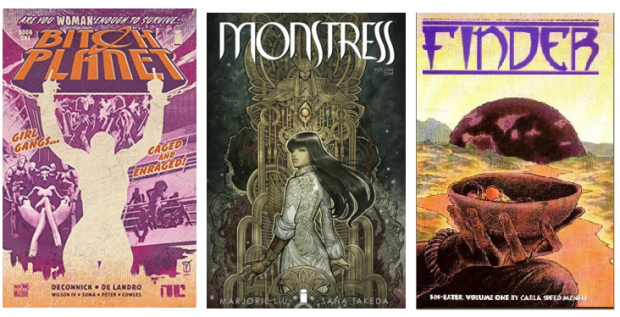
37: Graphic-Novel-Reihe: Kelly Sue DeConnick, „Bitch Planet“
- neue Comic-Heftreihe, der erste Sammelband erschien im Oktober 2015
- Die beliebte Autorin des (ziemlich mauen) „Captain Marvel“-Comics erzählt eine 70er-Jahre-Exploitation-Space-Opera über einen Weltraum-Knast voller Frauen. Tolle Zeichnungen.
„In a future just a few years down the road in the wrong direction, a woman’s failure to comply with her patriarchal overlords will result in exile to the meanest penal planet in the galaxy. When the newest crop of fresh femmes arrive, can they work together to stay alive or will hidden agendas, crooked guards, and the deadliest sport on (or off!) Earth take them to their maker?“ [Klappentext]
.
38: Graphic-Novel-Reihe: Marjorie Liu, „Monstress“
- neue Comic-Heftreihe, der erste Sammelband erscheint im Juli 2016
- Gefällige, aber etwas harmlose Zeichnungen; interessante Figuren – ich hoffe, das wird erfolgreich genug, um drei, vier Jahre lang eine Fantasy-Welt gut zu gestalten und auszubauen.
„Set in an alternate matriarchal 1900’s Asia, in a richly imagined world of art deco-inflected steampunk, MONSTRESS tells the story of a teenage girl who is struggling to survive the trauma of war, and who shares a mysterious psychic link with a monster of tremendous power, a connection that will transform them both.“ [Klappentext]
.
39: Graphic-Novel-Reihe: Carla Speed McNeal, „Finder“
- seit 1999, bisher 10 Bände
- Die Zusammenfassungen lesen sich wie „Mad Max“, doch es geht furchtbar viel um Familie, junge Mädchen, Liebe für Büchern, rührselige Erlebnisse auf dem Wüsten-Wochenmarkt usw.
„Finder details the life of Jaeger, aboriginal detective, a scout and tracker of powerful loyalties but few allegiances.“ [Klappentext, gekürzt; ich las Band 4 und fand es zu kindlich/kitschig.]
.
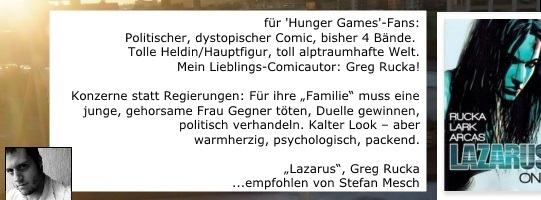
- John Brunner: „Stand on Zanzibar“
- Ismail Kadare: „The Palace of Dreams“
- Neal Stephenson: „Amalthea“
- Eric Shonkwiler: „Above all Men“
- Hugh Nissenson: „The Song of the Earth“
- Bucky Sinister: „Black Hole“
- Czeslaw Milosz: „The Captive Mind“
- Boris & Arkady Strugatsky: „Roadside Picknick“ / „Picknick am Wegesrand“
- China Miéville: „The City & the City“
- Herbert W. Franke: „Ypsilon Minus“
…und vielleicht Joe Haldemans (Mainstream-Space-Opera) „The Forever War“.
- Kinderbuch: „Oxygenien“ von Klára Fehér
- Zenna Hendersons „People“-Kurzgeschichten
- Die Hörspiele von Eva Maria Mudrich
- Gilda Musa (Italien, „Der häusliche Dschungel“)
- Olga Larionowa (Russland)
- Angela Steinmüller (oft zusammen mit ihrem Ehemann Karlheinz)
- die deutschsprachigen Autorinnen Anja Kümmel, Barbara Slawig und, vielleicht, Barbara Kirchner.
- Hedi Wyss: „Der Ozean steigt“
- Maria Pfannholz: „Den Überlebenden“
- „Ökofeministin“ Francoise d’Eaubonne: „Das Geheimnis des Mandelplaneten“
- und, zu Hard Sci-Fi: Ich mag Dietmar Dath und Andreas Brandhorst; und bin gespannt auf Dan Simmons und den deutschen Selfpublishing-Autor Thariot









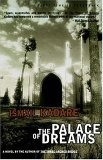








Noch mehr Futter für das Thema: die letztes Jahr erschienene Anthology „Sisters of the Revolution: A Feminist Speculative Fiction Anthology „: http://www.isfdb.org/cgi-bin/pl.cgi?496504
Interessante Liste, wird mich definitiv beschäftigen ;-). Hast du schon „Drei Sonnen“ von Cixin Liu gelesen? Das Buch (der erste Band einer Trilogie, die anderen habe ich noch nicht gelesen) erfüllt meiner Meinung nach deine Kriterien: interessante Frauenfiguren und einen klugen Blick auf Geschlecht und Gesellschaft. Wenn ja, würde mich interessieren, wie es dir gefallen hat.
Herziche Grüße
Maike